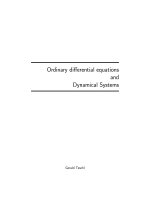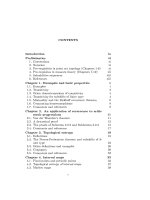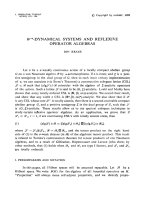- Trang chủ >>
- Khoa Học Tự Nhiên >>
- Vật lý
antoniou i. (ed.) dynamical systems and irreversibility.. proc. xxi solvay congress in physics
Bạn đang xem bản rút gọn của tài liệu. Xem và tải ngay bản đầy đủ của tài liệu tại đây (1.82 MB, 378 trang )
DYNAMICAL SYSTEMS
AND IRREVERSIBILITY
A SPECIAL VOLUME OF ADVANCES IN CHEMICAL PHYSICS
VOLUME 122
EDITORIAL BOARD
B
RUCE J. BERNE, Department of Chemistry, Columbia University, New York,
New York, U.S.A.
K
URT BINDER, Institut fu
¨
r Physik, Johannes Gutenberg-Universita
¨
t Mainz, Mainz,
Germany
A. W
ELFORD CASTLEMAN,JR., Department of Chemistry, The Pennsylvania State
University, University Park, Pennsylvania, U.S.A.
D
AVID CHANDLER, Department of Chemistry, University of California, Berkeley,
California, U.S.A.
M. S. C
HILD, Department of Theoretical Chemistry, University of Oxford, Oxford,
U.K.
W
ILLIAM T. COFFEY, Department of Microelectronics and Electrical Engineering,
Trinity College, University of Dublin, Dublin, Ireland
F. F
LEMING CRIM, Department of Chemistry, University of Wisconsin, Madison,
Wisconsin, U.S.A.
E
RNEST R. DAVIDSON, Department of Chemistry, Indiana University, Bloomington,
Indiana, U.S.A.
G
RAHAM R. FLEMING, Department of Chemistry, The University of California,
Berkeley, California, U.S.A.
K
ARL F. FREED, The James Franck Institute, The University of Chicago, Chicago,
Illinois, U.S.A.
P
IERRE GASPARD, Center for Nonlinear Phenomena and Complex Systems,
Universite
´
Libre de Bruxelles, Brussels, Belgium
E
RIC J. HELLER, Department of Chemistry, Harvard-Smithsonian Center for
Astrophysics, Cambridge, Massachusetts, U.S.A.
R
OBIN M. HOCHSTRASSER, Department of Chemistry, The University of Pennsylvania,
Philadelphia, Pennsylvania, U.S.A.
R. K
OSLOFF, The Fritz Haber Research Center for Molecular Dynamics and Depart-
ment of Physical Chemistry, The Hebrew University of Jerusalem, Jerusalem,
Israel
R
UDOLPH A. MARCUS, Department of Chemistry, California Institute of Technology,
Pasadena, California, U.S.A.
G. N
ICOLIS, Center for Nonlinear Phenomena and Complex Systems, Universite
´
Libre de Bruxelles, Brussels, Belgium
T
HOMAS P. RUSSELL, Department of Polymer Science, University of Massachusetts,
Amherst, Massachusetts
D
ONALD G. TRUHLAR, Department of Chemistry, University of Minnesota,
Minneapolis, Minnesota, U.S.A.
J
OHN D. WEEKS , Institute for Physical Science and Technology and Department
of Chemistry, University of Maryland, College Park, Maryland, U.S.A.
P
ETER G. WOLYNES, Department of Chemistry, University of California, San Diego,
California, U.S.A.
DYNAMICAL SYSTEMS
AND IRREVERSIBILITY:
PROCEEDINGS OF THE
XXI SOLVAY CONFERENCE
ON PHYSICS
ADVANCES IN CHEMICAL PHYSICS
VOLUME 122
Edited by
IOANNIS ANTONIOU
International Solvay Institutes for Physics and Chemistry, Brussels, Belgium
Series Editors
I. PRIGOGINE STUART A. RICE
Center for Studies in Statistical Mechanics Department of Chemistry
and Complex Systems and
The University of Texas The James Franck Institute
Austin, Texas The University of Chicago
and Chicago, Illinois
International Solvay Institutes
Universite
´
Libre de Bruxelles
Brussels, Belgium
AN INTERSCIENCE PUBLICATION
JOHN WILEY & SONS, INC.
This book is printed on acid-free paper.
Copyright # 2002 by John Wiley & Sons, Inc., New York. All rights reserved.
Published simultaneously in Canada.
No part of this publication may be reproduced, stored in a retrieval system or transmitted in any
form or by any means, electronic, mechanical, photocopying, recording, scanning or otherwise,
except as permitted under Section 107 or 108 of the 1976 United States Copyright Act, without
either the prior written permission of the Publisher, or authorization through payment of the
appropriate per-copy fee to the Copyright Clearance Center, 222 Rosewood Drive, Danvers, MA
01923, (978) 750-8400, fax (978) 750-4744. Requests to the Publisher for permission should be
addressed to the Permissions Department, John Wiley & Sons, Inc., 605 Third Avenue, New York,
NY 10158-0012, (212) 850-6011, fax (212) 850-6008, E-Mail:
For ordering and customer service, call 1-800-CALL-WILEY
Library of Congress Catalog Number: 58-9935
ISBN 0-471-22291-7
Printed in the United States of America.
10987654321
CONTRIBUTORS TO VOLUME 122
L. ACCARDI, Centro Vito Volterra, Polymathematics, Facolta di Economia,
Universita degli Studi di Roma Tor Vergata, Rome, Italy
Y. A
IZAWA, Department of Applied Physics, Faculty of Science and Engineer-
ing, Waseda University, Tokyo, Japan
I. A
NTONIOU, International Solvay Institutes for Physics and Chemistry, Free
University of Brussels, Brussels, Belgium; and Theoretische Natuurkunde,
Free University of Brussels, Brussels, Belgium
F. T. A
RECCHI, Department of Physics, University of Florence, Florence, Italy;
and National Institute of Applied Optics (INOA), Florence, Italy
R. B
ALESCU, Department of Physical Statistics–Plasma, Free University of
Brussels, Brussels, Belgium
A. B
OHM, Department of Physics, University of Texas, Austin, Texas, U.S.A.
L
UIS J. BOYA, Center for Particle Physics, Department of Physics, The
University of Texas, Austin, Texas, U.S.A. Permanent address: Department
of Theoretical Physics, Faculty of Science, University of Zaragoza,
Zaragoza, Spain
P
IERRE GASPARD, Center for Nonlinear Phenomena and Complex Systems, Free
University of Brussels, Brussels, Belgium
K
ARL GUSTAFSON, Department of Mathematics, University of Colorado,
Boulder, Colorado, U.S.A.; and International Solvay Institutes for Physics
and Chemistry, University of Brussels, Brussels, Belgium
H
IROSHI H. HASEGAWA, Department of Mathematical Sciences, Ibaraki
University, Mito, Japan; and Center for Statistical Mechanics, University
of Texas, Austin, Texas, U.S.A.
K
UNIHIKO KANEKO, Department of Pure and Applied Sciences, College of Arts
and Sciences, University of Tokyo, Tokyo, Japan
E. K
ARPOV, Center for Studies in Statistical Mechanics and Complex Systems,
University of Texas, Austin, Texas, U.S.A.; and International Solvay
Institutes for Physics and Chemistry, Free University of Brussels, Brussels,
Belgium
S. V. K
OZYREV, Centro Vito Volterra, Polymathematics, Facolta di Economia,
Universita degli Studi di Roma Tor Vergata, Rome, Italy
v
MIKIO NAMIKI, Department of Physics, Waseda University, Tokyo, Japan
G. O
RDONEZ, Center for Studies in Statistical Mechanics and Complex Systems,
University of Texas, Austin, Texas, U.S.A.; and International Solvay
Institutes for Physics and Chemistry, Free University of Brussels, Brussels,
Belgium
T. P
ETROSKY, Center for Studies in Statistical Mechanics and Complex Systems,
University of Texas, Austin, Texas, U.S.A.; International Solvay Institutes
for Physics and Chemistry, Free University of Brussels, Brussels, Belgium;
and Theoretical Physics Department, University of Vrije, Brussels,
Belgium
I. P
RIGOGINE, Center for Studies in Statistical Mechanics and Complex Systems,
The University of Texas, Austin, Texas, U.S.A.; and International Solvay
Institutes for Physics and Chemistry, Free University of Brussels, Brussels,
Belgium
Z. S
UCHANECKI, International Solvay Institutes for Physics and Chemistry, Free
University of Brussels, Brussels, Belgium; Theoretische Natuurkunde,
Free University of Brussels, Brussels, Belgium; and Institute of Mathe-
matics, University of Opole, Opole, Poland
E. C. G. S
UDARSHAN, Center for Particle Physics, Department of Physics, The
University of Texas, Austin, Texas, U.S.A.
P. S
ZE
´
PFALUSY, Department of Physics of Complex Systems, Eo
¨
tvo
¨
s University,
Budapest, Hungary; and Research Institute for Solid State Physics and
Optics, Budapest, Hungary
S. T
ASAKI, Department of Physics, Nara Women’s University, Nara, Japan; and
Institute for Fundamental Chemistry, Kyoto, Japan. Present address:
Department of Applied Physics and Advanced Institute for Complex
Systems, Waseda University, Tokyo, Japan
H. W
ALTHER, Sektion Physik der Universita
¨
tMu
¨
nchen and Max Planck Institut
fu
¨
r Quantenoptik, Garching, Federal Republic of Germany
vi contributors to volume 122
ADMINISTRATIVE BOARD OF THE
INTERNATIONAL SOLVAY INSTITUTES
FOR PHYSICS AND CHEMISTRY
J. SOLVAY President of the Administrative Board
F. B
INGEN Vice-President of the Administrative Board
I. P
RIGOGINE Director of the Solvay Institutes
I. A
NTONIOU Deputy Director of the Solvay Institutes
F. L
AMBERT Secretary of the Administrative Board
A. B
ELLEMANS Secretary of the Scientific Committee of Chemistry
M. H
ENNEAUX Secretary of the Scientific Committee of Physics
D. J
ANSSEN
A. JAUMOTTE
G. NICOLIS
J. M. PIRET
J. REISSE
R. LEFEVER
vii
SCIENTIFIC COMMITTEE FOR PHYSICS OF
THE INTERNATIONAL SOLVAY INSTITUTES
FOR PHYSICS AND CHEMISTRY
A. ABRAGAM Professeur Honoraire au Colle
`
ge de France, Paris,
France
P. W. A
NDERSON Department of Physics, Princeton University,
Princeton, NJ, U.S.A.
F. T. A
RECCHI Directeur, Istituto Nazionale de Ottica Applicata,
Florence, Italy
M. H
ENNEAUX De
´
partement de Physique, Universite
´
Libre de
Bruxelles, Bruxelles, Belgium
I. M. K
HALATNIKOFF Russian Academy of Sciences, Landau Institute of
Theoretical Physics, Moscow, Russia
Y. N
E’EMAN Sackler Institute for Advanced Study, Tel-Aviv
University, Tel Aviv, Israel
D. P
HILLIPS 35, Addisland Court, Holland Villas Road, London,
England
R. Z. S
AGDEEV East West Place Science Center, University of
Maryland, College Park, MD, U.S.A.
G. S
ETTI European Southern Laboratory, Munich,
Germany
G. t’H
OOFT Institute for Theoretical Physics, Utrecht University,
Utrecht, Netherlands
S. C. T
ONWAR Tata Institute for Fundamental Research, Bombay,
India
H. W
ALTHER Max-Planck-Institute fu
¨
r Quantenoptik, Mu
¨
nich,
Germany
V. F. W
EISSKOPF Department of Physics, Massachusetts Institute of
Technology, Cambridge, MA, U.S.A.
ix
THE SOLVAY CONFERENCES ON PHYSICS
The Solvay conferences started in 1911. The first conference on radiation
theory and the quanta was held in Brussels. This was a new type of
conference and it became the tradition of the Solvay conference; the
participants are informed experts in a given field and meet to discuss one or
a few mutually related problems of fundamental importance and seek to
define the steps for the solution.
The Solvay conferences in physics have made substantial contributions to
the development of modern physics in the twentieth century.
1. (1911) ‘‘Radiation theory and the quanta’’
2. (1913) ‘‘The structure of matter’’
3. (1921) ‘‘Atoms and electrons’’
4. (1924) ‘‘Electric conductivity of metals’’
5. (1927) ‘‘Electrons and photons’’
6. (1930) ‘‘Magnetism’’
7. (1933) ‘‘Structure and properties of the atomic nuclei’’
8. (1948) ‘‘Elementary particles’’
9. (1951) ‘‘Solid state’’
10. (1954) ‘‘Electrons in metals’’
11. (1958) ‘‘The structure and evolution of the universe’’
12. (1961) ‘‘The quantum theory of fields’’
13. (1964) ‘‘The structure and evolution of galaxies’’
14. (1967) ‘‘Fundamental problems in elementary particle physics’’
15. (1970) ‘‘Symmetry properties of nuclei’’
16. (1973) ‘‘Astrophysics and gravitation’’
17. (1978) ‘‘Order and fluctuations in equilibrium and nonequilibrium
statistical mechanics’’
18. (1982) ‘‘High-energy physics. What are the possibilities for extending our
understanding of elementary particles and their interactions to much greater
energies?’’
19. (1987) ‘‘Surface science’’
20. (1991) ‘‘Quantum optics’’
21. (1998) ‘‘Dynamical systems and irreversibility’’
For more information, visit the website of the Solvay Institutes
xi
XXIst INTERNATIONAL SOLVAY CONFERENCE IN PHYSICS,
KEIHANNA PLAZA, NOVEMBER 1
–5, 1998
DYNAMICAL SYSTEMS AND IRREVERSIBILITY
(Top row) M. Miyamoto, H. Takahashi, H. Nakazato, G. Ordonez,
H. Fujisaka, S. Sasa, H. Hasegawa, Y. Ootaki, A. Oono
(Fourth row from bottom) M. Gadella, A. Bohm, R. Willox,
K. Sekimoto, T. Arimitsu, K. Kaneko, D. Driebe, S. Tasaki, Y. Ichikaw
a
(Third row from bottom) F. Lambert, K. Gustafson, J. R. Do
rfman, M.Ernst, S. Pascazio, T. Hida, B. Pavlov, Y. Aizawa, Yu. Meln
ikov, T. Petrosky, A. Awazu
(Second row from bottom) K. Kitahara, Ya. Sinai, I. Antoniou, L. Accardi,
H. Hegerfeldt, O’Dae Kwon, P. Szepfalusy, M. Namiki, L. Boya,
K. Kawasaki,
H. Posch, P. Gaspa
(Bottom row) R. Balescu, Hao Bai-lin, H. Mori, H. Walther, J
. Kondo, I. Prigogine, J. Solvay, L. Reichl, N. G. van Kampen, T. Arecchi,
S. C. Tonwar
CONTENTS
Administrative Board of the International Solvay
Institutes for Physics and Chemistry vii
Scientific Committee for Physics of the International
Solvay Institutes for Physics and Chemistry ix
The Solvay Conferences on Physics xi
Preface xv
Opening Speech by J. Solvay xvii
Introductory Remarks by Ilya Prigogine xxi
PART ONE
DISCRETE MAPS
Non-Markovian Effects in the Standard Map 3
By R. Balescu
Thermodynamics of a Simple Hamiltonian Chaotic System 21
By Hiroshi H. Hasegawa
Harmonic Analysis of Unstable Systems 33
By I. Antoniou and Z. Suchanecki
Properties of Permanent and Transient Chaos in Critical States 49
By P. Sze
´
pfalusy
From Coupled Dynamical Systems to Biological Irreversibility 53
By Kunihiko Kaneko
PART TWO
TRANSPORT AND DIFFUSION
Irreversibility in Reversible Multibaker Maps —Transport
and Fractal Distributions 77
By S. Tasaki
Diffusion and the Poincare
´
–Birkhoff Mapping
of Chaotic Systems 109
By Pierre Gaspard
xiii
Transport Theory for Collective Modes and Green–Kubo
Formalism for Moderately Dense Gases 129
By T. Petrosky
New Kinetic Laws of Cluster Formation in N-Body
Hamiltonian Systems 161
By Y. Aizawa
PART THREE
QUANTUM THEORY, MEASUREMENT, AND DECOHERENCE
Quantum Phenomena of Single Atoms 167
By H. Walther
Quantum Superpositions and Decoherence: How to Detect
Interference of Macroscopically Distinct Optical States 199
By F. T. Arecchi and A. Montina
Quantum Decoherence and the Glauber Dynamics from the
Stochastic Limit 215
By L. Accardi and S. V. Kozyrev
CP Violation as Antieigenvector-Breaking 239
By K. Gustafson
PART FOUR
EXTENSION OF QUANTUM THEORY AND FIELD THEORY
Dynamics of Correlations. A Formalism for Both Integrable
and Nonintegrable Dynamical Systems 261
By I. Prigogine
Generalized Quantum Field Theory 277
By E. C. G. Sudarshan and Luis J. Boya
Age and Age Fluctuations in an Unstable Quantum System 287
By G. Ordonez, T. Petrosky, and E. Karpov
Microphysical Irreversibility and Time Asymmetric Quantum
Mechanics 301
By A. Bohm
Possible Origins of Quantum Fluctuation Given by
Alternative Quantization Rules 321
By Mikio Namiki
Author Index 331
Subject Index 339
xiv contents
PREFACE
This volume contains the contributions to the XXIst Solvay Conference on
Physics, which took place at the Keihanna Interaction Plaza in the Kansaı
¨
Science City. The topic was Dynamical Systems and Irreversibility.
The conference has been made possible thanks to the support of the
Keihanna Foundation, the Honda Foundation, and the International Solvay
Institutes for Physics and Chemistry, founded by E. Solvay.
Ioannis Antoniou
xv
OPENING SPEECH BY J. SOLVAY
Ladies and Gentlemen,
It is a great pleasure and honor to open here the XXIst Solvay Conference on
Physics. Generally, the Conferences are held in Brussels. There were also a few
organized in the United States. This is the first Solvay meeting organized in
Japan. I would like to interpret this conference as a sign of admiration for the
creativity of Japanese scientists. May I first tell you an anecdote? Ernest Solvay,
my great-grandfather, was a man of multiple interests. He was equally attracted
by physics, chemistry, physiology, and sociology. He was in regular correspon-
dence with outstanding people of his time, such as Nernst and Ostwald. This
was a period where the first difficulty had appeared in the interpretation of the
specific heat by classical physics. Ernest Solvay was bold enough to have his
own opinion on this subject. He thought there were surface tension effects, and
he expressed his view in a meeting with Nernst in 1910. Nernst was a practical
man. He immediately suggested that Ernest Solvay should organize an inter-
national meeting to present his point of view. This was the starting point for the
Solvay Conferences, the first of which took place in 1911. The Chairman was
the famous physicist H. A. Lorentz. At the end of the conference, Lorentz
thanked Ernest Solvay not only for his hospitality but also for his scientific
contribution. However, in fact his contribution was not even discussed during
the meeting. Ernest Solvay was not too disappointed. He thought he had just to
continue to work and appreciated greatly the first conference dealing with
radiation theory and quanta. He therefore decided to organize the ‘‘Solvay
Institute for Physics,’’ which was founded in May 1912. He called it the
‘‘Institut International de Physique’’ with the goal ‘‘to encourage research which
would extend and deepen the knowledge of natural phenomena.’’ The new
foundation was intended to concentrate on the ‘‘progress of physics.’’ Article 10
of the statutes required that ‘‘at times determined by the Scientific Committee a
‘Conseil de Physique,’ analogous to the one convened by Mr. Solvay in October
1911, will gather, having for its goal the examination of significant problems of
physics.’’ A little later, Ernest Solvay established another foundation ‘‘Institut
International de Chimie.’’ The foundations were ultimately united into ‘‘Les
Instituts Internationaux de Physique et de Chimie,’’ each having its own
Scientific Committee.
The first Solvay Conference on Physics had set the style for a new type of
scientific meetings, in which a select group of the most well informed experts in
a given field would meet to discuss the problems at the frontiers and would seek
xvii
to identify the steps for their solution. Except for the interruptions caused by the
two World Wars, these international conferences on physics have taken place
almost regularly since 1911, mostly in Brussels. They have been unique
occasions for physicists to discuss the fundamental problems that were at the
center of interest at different periods and have stimulated the development of
physical science in many ways. This was a time where international meetings
were very exceptional. The Solvay Conferences were unexpectedly successful.
In his foreword to the book by Jadgish Mehra, ‘‘The Solvay Conferences on
Physics,’’ Heisenberg wrote:
I have taken up these reminiscences in this foreword in order to emphasise
that the historical influence of the Solvay Conferences on the development of
physics was connected with the special style introduced by their founder. The
Solvay Meetings have stood as an example of how much well-planned and
well-organised conferences can contribute to the progress of science.
It was often said that the people who met at Solvay Conferences went
subsequently to Stockholm to receive the Nobel Prize. This is perhaps a little
exaggerated, but there is some truth. It is also at the Solvay Conference in 1930
that one of the most famous discussions in the history of science took place.
This was the discussion between Einstein and Bohr on the foundations of
Quantum theory. Nearly 70 years later it is remarkable to notice that physicists
seem not to agree on who won in this discussion.
There is another, more personal aspect that influences the development of the
Solvay Conferences. When my friend Ilya Prigogine some 40 years ago in 1958
was nominated Director of the Institutes, he extended their activities from
organizing conferences to doing research in a direction that encompasses
today’s theme, ‘‘Irreversible Processes and Dynamical Systems.’’
The Institutes evolved into a mini Institute for Advanced Study centered
around complex systems, nonlinear dynamics, and thermodynamics. In that
role, they were an impressive success. Work done within the Institutes shows
that far from equilibrium, matter acquires new properties that form the basis of a
new coherence. These results introduced the concept of auto-organization,
which is echoed into economic and social sciences. These innovations were
the reason for Professor Prigogine’s 1977 Nobel Prize.
We all know Professor Prigogine’s passion for the understanding of time. The
flow of time is present on various levels of observations, be it cosmology,
thermodynamics, biology, or economics. Moreover, time is the basic existential
dimension of man, and nobody can remain indifferent to the problem of
time. We all care for the future, especially in the transition period in which
we live today. Curiously, the place of time in physics is still a controversial
subject. I hope that this conference will make a significant contribution to this
vast subject.
xviii OPENING SPEECH BY J. SOLVAY
My gratitude goes to the local committee that has organized this conference.
Finally, I want to thank Keihanna Plaza for the magnificent hospitality we
have received there. I would also like to acknowledge the Honda Foundation,
Unoue Foundation, L’Oreal Foundation, the Consul of Belgium and the European
Commission for financial contributions that have made this conference possible.
OPENING SPEECH BY J. SOLVAY xix
INTRODUCTORY REMARKS
BY ILYA PRIGOGINE
I am happy to open the XXIst Solvay Conference on Physics, especially as it
takes place in Japan, in this beautiful setting.
The organization of the Solvay Conference in Kansaı
¨
Science City is a fitting
tribute to Japanese science. I want also to thank the staff of the Keihanna
Interaction Plaza and especially Mr. Yasuki Takeshima for the hospitality and
the local organization committee chaired by Professor Kitahara, who was many
times our honored guest in Brussels. I am very grateful to Professor Ioannis
Antoniou for his help in the organization of this Conference.
Over the years I had many Japanese students. The first was Professor Toda
and the most recent were Professors Tasaki and Hasegawa, who are here. My
Japanese co-workers had a decisive influence on the evolution of the work of the
Brussels–Austin group.
The subject of the XXIst Conference, ‘‘Dynamical Systems and the Arrow of
Time,’’ is closest to the XVIIth conference, ‘‘Order and Fluctuations in
Equilibrium and Nonequilibrium Statistical Mechanics,’’ held in 1978. It is a
pleasure to mention that a number of people who participated in the 1978
conference are here. Let me mention Professors Arecchi, Balescu, Hao Bai Lin,
Kitahara, Reichl, Sinai, ; I hope I have not omitted anyone.
In the XVIIth Conference, much time was devoted to equilibrium critical
phenomena and to macroscopic nonequilibrium dissipative structures. A high
point was the discussion around the statement by Professor Philip Anderson that
dissipative structures have no intrinsic character as they would depend on the
boundary conditions. This led to hot discussions that have gone on for years. I
believe that this question is now resolved by the experimental discovery of
Turing structures with intrinsic wave lengths. At no previous Solvay Conference
was the relation between irreversibility and dynamics systematically discussed.
However, this is a fascinating subject as we discover irreversible processes at all
levels of observations, from cosmology to chemistry or biology.
This is a kind of paradox. It is well known that classical or quantum
dynamics lead to a time-reversible, deterministic description. In contrast, both
kinetic theory and thermodynamics describe probabilistic processes with broken
time symmetry. Kinetic theory and thermodynamics have been quite successful.
It is therefore quite unlikely that they can be attributed to approximations
introduced in dynamics. Many attempts have been now developed to give a
deeper formulation to the problem.
xxi
From this point of view, there is some similarity between the goal of the first
Solvay Conference held in 1911 and the present conference at the end of the
century. In 1911, the question was how to formulate the laws of nature to include
quantum effects. Now we ask if irreversibility is the outcome of approximations
or if we can formulate microscopic basic laws that include time symmetry
breaking.
In my long experience, I always found that the problem of time leads to
much passion. So I look forward with great expectations to this conference.
xxii introductory remarks by ilya prigogine
PART ONE
DISCRETE MAPS









